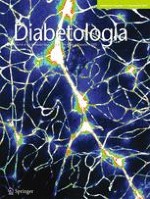Published in:

01-11-2017 | Article
Metabolic crosstalk between fatty pancreas and fatty liver: effects on local inflammation and insulin secretion
Authors:
Felicia Gerst, Robert Wagner, Gabriele Kaiser, Madhura Panse, Martin Heni, Jürgen Machann, Malte N. Bongers, Tina Sartorius, Bence Sipos, Falko Fend, Christian Thiel, Silvio Nadalin, Alfred Königsrainer, Norbert Stefan, Andreas Fritsche, Hans-Ulrich Häring, Susanne Ullrich, Dorothea Siegel-Axel
Published in:
Diabetologia
|
Issue 11/2017
Login to get access
Abstract
Aims/hypothesis
Obesity-linked ectopic fat accumulation is associated with the development of type 2 diabetes. Whether pancreatic and liver steatosis impairs insulin secretion is controversial. We examined the crosstalk of human pancreatic fat cells with islets and the role of diabetogenic factors, i.e. palmitate and fetuin-A, a hepatokine released from fatty liver.
Methods
Human pancreatic resections were immunohistochemically stained for insulin, glucagon, somatostatin and the macrophage/monocyte marker CD68. Pancreatic adipocytes were identified by Oil Red O and adiponectin staining. Primary pancreatic pre-adipocytes and differentiated adipocytes were co-cultured with human islets isolated from organ donors and the metabolic crosstalk between fatty liver and fatty pancreas was mimicked by the addition of palmitate and fetuin-A. Insulin secretion was evaluated by ELISA and RIA. Cytokine expression and secretion were assessed by RT-PCR and multiplex assay, respectively. Subcellular distribution of proteins was examined by confocal microscopy and protein phosphorylation by western blotting.
Results
In human pancreatic parenchyma, highly differentiated adipocytes were detected in the proximity of islets with normal architecture and hormone distribution. Infiltration of adipocytes was associated with an increased number of CD68-positive cells within islets. In isolated primary pancreatic pre-adipocytes and differentiated adipocytes, palmitate and fetuin-A induced IL6, CXCL8 and CCL2 mRNA expression. Cytokine production was toll-like receptor 4 (TLR4)-dependent and further accentuated in pre-adipocytes when co-cultured with islets. In islets, IL6 and CXCL8 mRNA levels were also increased by fetuin-A and palmitate. Only in macrophages within the isolated islets, palmitate and fetuin-A stimulated the production of the cytotoxic cytokine IL-1β. Palmitate, but not fetuin-A, exerted pro-apoptotic effects in islet cells. Instead, fetuin-A impaired glucose-induced insulin secretion in a TLR4-independent, but c-Jun N-terminal kinase- and Ca2+-dependent, manner.
Conclusions/interpretation
These results provide the first evidence that fetuin-A-mediated metabolic crosstalk of fatty liver with islets may contribute to obesity-linked glucose blindness of beta cells, while fatty pancreas may exacerbate local inflammation.